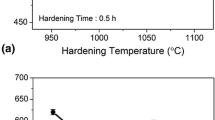Abstract
This paper presents the results of a systematic study of the effect of carbon, manganese, phosphorus, silicon, nickel, chromium, molybdenum, and vanadium on the hardness of martensite in low to medium carbon steels tempered for one hour at 100°F (56°C) intervals in the range 400 to 1300°F (204 to 704°C). Results show that the as-quenched hardness depends solely on carbon content. On tempering, the effect of carbon on hardness decreases markedly with increasing tempering temperature. Studies of carbon-0.5 manganese steels showed that the incremental increase in hardness from 0.5 pct manganese after a given tempering treatment was independent of carbon content. Based on this result, studies of the effects of the other alloying elements were made using a 0.2 or 0.3 pct carbon, 0.3 to 0.5 pct manganese steel base composition. The hardness of the resulting tempered martensite was assumed to be due to a given alloy addition, and when two or more alloying elements were added, their effects were assumed to be additive.
Each of the seven alloying elements increased the hardness of tempered martensite by varying amounts, the increase being greater as more of each element was present. Nickel and phosphorus have substantially the same effect at all tempering temperatures. Manganese has essentially the same hardening effect at any temperature in the range 700 (371°C) to 1300°F; silicon is most effective at 600°F (316°C), chromium at 800°F (427°C), molybdenum at 1000 to 1100°F (538 to 592°C), and vanadium at 1200°F (649°C).
Using the data obtained, a procedure is established for calculating the hardness of tempered martensite for carbon and alloy steel compositions in the range studied and for any combination of tempering time and temperature.
Similar content being viewed by others
References
J. H. Hollomon and L. D. Jaffe:Ferrous Metallurgical Design, John Wiley and Sons, Inc., 1947, p. 2.
E. C. Bain and H. W. Paxton:The Alloying Elements in Steel, 2nd ed., American Society for Metals, Metals Park, Ohio, 1961.
W. Crafts and V. L. Lamont:Trans. AIME, 1949, vol. 180, pp. 471–512.
R. A. Grange and R. W. Baughman:Trans. ASM, 1956, vol. 48, pp. 165–97.
L. D. Jaffe and E. Gordon:Trans. ASM, 1957, vol. 49, pp. 359–71.
G. R. Speich and W. C. Leslie:Met. Trans., 1972, vol. 3, pp. 1043–54.
A. G. Allten and P. Payson:Trans. ASM, 1953, vol. 45, pp. 498–532.
J. H. Hollomon and L. D. Jaffe:Trans. TMS-AIME, 1945, vol. 162, pp. 223–49.
Author information
Authors and Affiliations
Additional information
R. A. GRANGE was formerly with U. S. Steel Corporation (retired)
Rights and permissions
About this article
Cite this article
Grange, R.A., Hribal, C.R. & Porter, L.F. Hardness of tempered martensite in carbon and low-alloy steels. Metall Trans A 8, 1775–1785 (1977). https://doi.org/10.1007/BF02646882
Received:
Issue Date:
DOI: https://doi.org/10.1007/BF02646882




